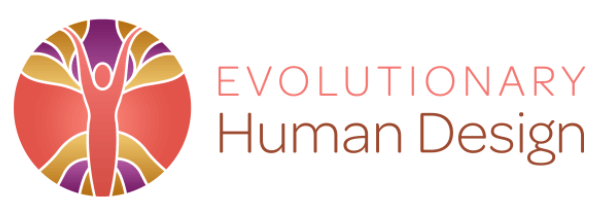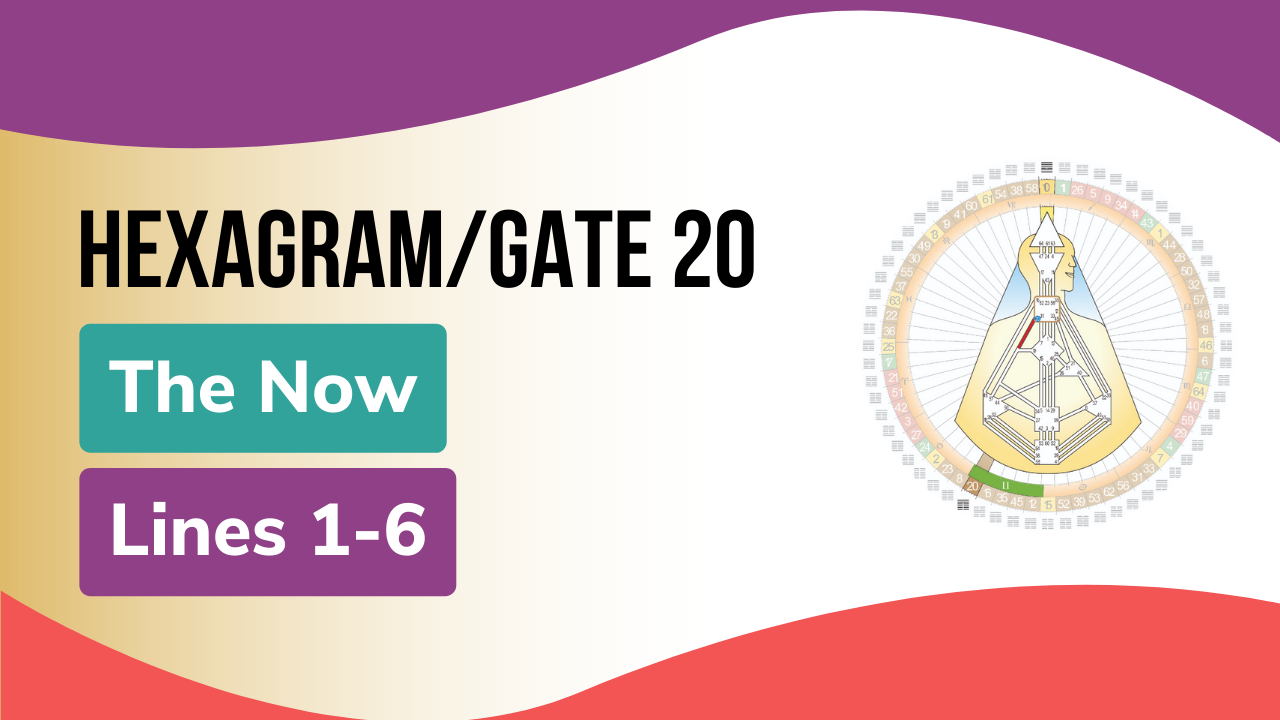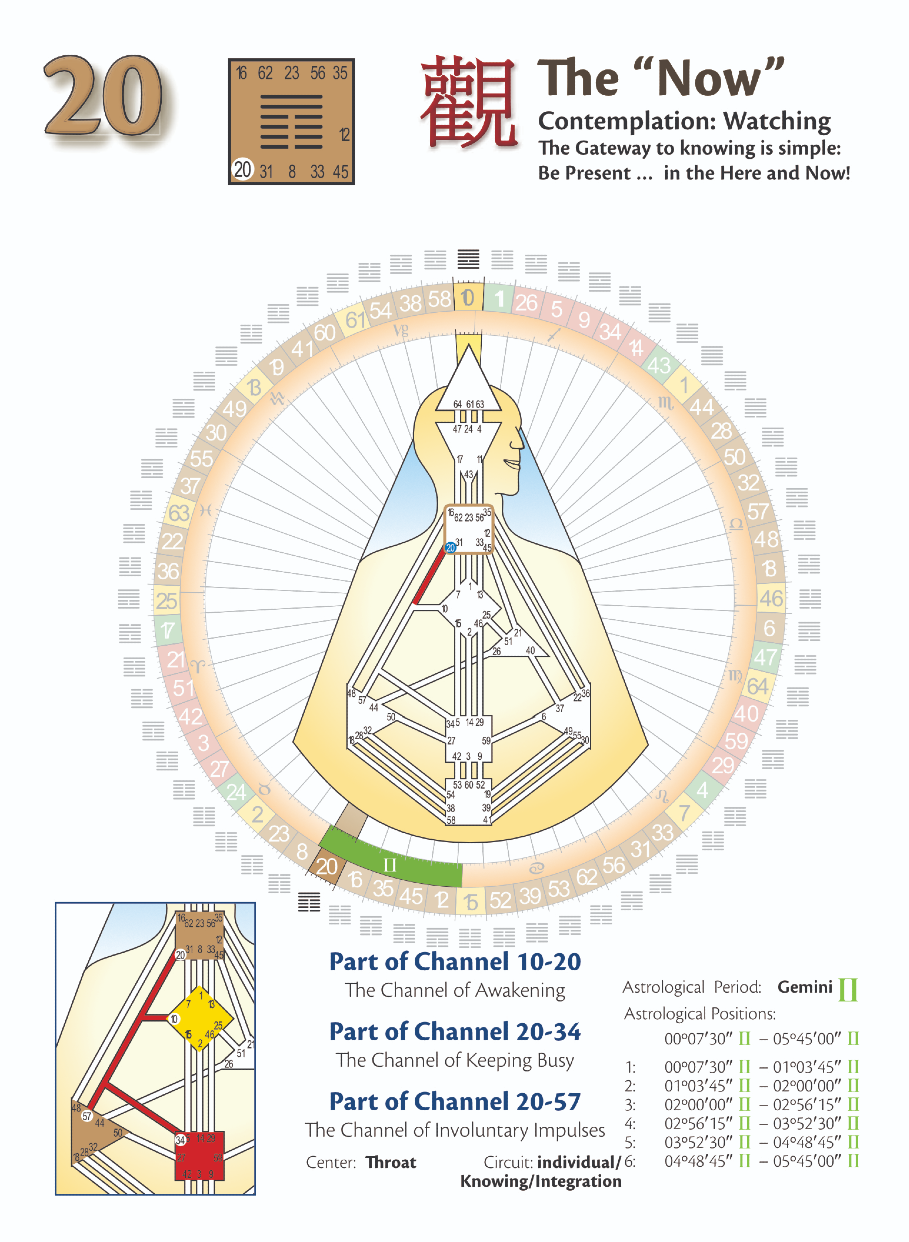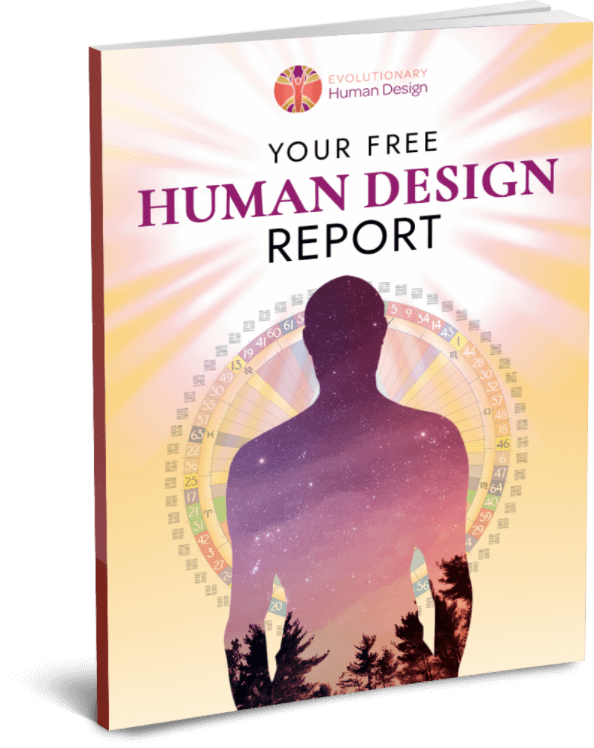Last time, we explored Hexagram 8, learning how to become the facilitators of creativity and novel ideals in a changing world. Now, the sun is moving into Human Design Gate 20, which we call “The Now.”
The 20th gateway is in the Individual Circuitry. But it’s also in what we call the Integration Circuitry. And you could say that physiologically, the Integration Circuitry relates to the spine. It’s what holds the whole thing together. We use the spine in language to refer to individuality and assertiveness. If someone unsure of themselves, we might call them “spineless” and tell them to “show a little backbone.” And so, the 20th Gateway is the expression of that energy that runs through us as individuals. We express it in our own very individual way, according to our own nature, according to our own sense of truth.
Like gate 20, the previous two gates were in the throat center. But where Gate 23 was all about receiving and transmitting new concepts and ideals, and Gate 8 was about facilitating their implementation, Gate 20 is about what’s happening right now. We’ve got all these references from our past to draw from, we’ve got all kinds of concepts and ideas about the future. But what’s the deal right now, in this moment?
The 20th gateway is all about the present tense. Every now and again in life you’ll find yourself pulled into the present. You could be driving around from place to place, rushing to get some errands done, and suddenly you see a signpost that says, “Scenic Viewpoint Up Ahead.” You take a moment to stop, park, get out of the car and enjoy the view, take in the beauty of the place, and feel the stillness of the moment. Suddenly you’re not racing down the road anymore. You’re not in a hurry to get somewhere. There’s a complete shift from the busy process of life as you’re brought into the present tense.
It’s good to remember, and remind ourselves, that life is present tense. When you’re burdened with problems, worried about the future, or overwhelmed by the complications of life, the moment you snap into the present tense, there isn’t a problem. You can always dive back into the problem matrix again, but in the present tense, there’s just this moment, and in this moment, you have the possibility to totally reconnect into yourself.
Let’s have a look at Human Design Gate 20 line by line:
First Line: Simplicity
The first line is called “Simplicity is the key to awareness.” Awareness is not a complicated thing. It’s just about being present. And you know when you get out of the car and walk towards that panoramic view, you don’t have to think about it, you don’t have to do anything. All of a sudden, you’re just in that moment, that precious moment. There’s nothing complicated about it. All you had to do was break the pattern, get off the mental merry-go-round, and allow yourself to come into the present tense.
Each small event is part of a larger scheme of events. Even the simplest things, when you link them together, you can see the larger consequence of it all. But, your own viewing of life is essential. You can’t view life as somebody else. It’s your life to live, and in the present tense, you have the quickest and simplest way of accessing what your life is all about in any moment in time.
You find beauty and harmony in apparent simplicity, but a moody oversimplification of life can cause you to shirk personal responsibility. It’s a call to be aware of the potential to shut life out, to make it so simple that you don’t even engage with life and the responsibilities that go along with it. It’s great to be in the moment, to enjoy the harmony of simplicity, but beware of taking it so far that you avoid it altogether.
Second Line: Viewpoint
The second line here is called, “Viewpoint: Weighing personal perspectives with the reality of the world.” Second lines can very easily just cruise through life. It can all be very natural and fun for them, not too complicated. They don’t necessarily need to get all wrapped up in other people’s stuff. And what this line says is, “be clear on what your own viewpoint is in any situation.”
This is not about dodging the reality. It’s about recognizing that you are part of the world, you’re living in the world here. So, how do you engage with it? What is your viewpoint? How do you find your presence in the world at any moment in time?
If your unaffected observations are not appreciated, you can easily become discouraged. Second lines have a certain natural quality, a simplicity about them. There’s also the potential in second lines to seek recognition, to want to be seen. And if there’s a sense that you’re being ignored as you go about things in your natural, somewhat simplistic way, you might begin to question yourself and feel the urge to make your life a little bit more complicated.
You broaden your perspective through finding harmony in every moment, but if you take everything seriously, you’ll form narrow and potentially moody viewpoints. It’s very easy to take life too seriously. To approach life as though it’s a problem we have to solve. But, the second line is really here to play, to play in the natural possibility of life, and in the harmony of the moment.
Third Line: Being Objective
Here, the third line is called “Being objective: Developing an ability to watch your thoughts and actions impassively.” You establish guidelines by dispassionately watching the effect you have on your world. We’re not disconnected here. As we put out, so the world gives back. As the world gives to us, we assimilate it and engage with it. And we recognize part of our world through what’s going on inside ourselves. And that’s what this third line is all about. It’s bringing our world and our life together in the present.
In the now, we’re not the body, we’re not the mind, we’re not the emotions. We’re witnessing consciousness. The great gift we have as human beings is to be able to watch ourselves, to witness ourselves, to witness what our life is all about. The body does its thing as our vessel, the mind is a great bio-computer that we have access to, our emotions provide wonderful texture and depth to our experience. But we are not these things. And the third line here is showing us that we have to stand back from it all, we have to watch what it is that’s being expressed.
So, honoring your witnessing consciousness assists you to glide through your life, but potential self-consciousness can be a stumbling block. It’s about the witnessing, the watching in the moment, maintaining that dispassionate awareness. Because when you are relating in the world, you get self-conscious, and suddenly lose that possibility of witnessing what it is that’s going on.
Fourth Line: Observing
The fourth line is called, “Observing: Promoting the best influences in your world.” Fourth lines always want to have everybody on board. Can we get everybody to come to the now? Can we all be present in playing in this world, acting in this world, working in this world together? So, it’s looking to provide the best influences. To find the best influences for everybody.
Enabling the best attributes, you expound knowledge in varied ways according to the requirements of the moment. It’s about recognizing that there are different ways of getting different people on board. Different moments call for different forms of expression. What is needed in this moment so that your influence really carries and gets people engaged and uplifted in what it is that’s being expressed?
You communicate through remarks that may or may not have instant practical value. Bringing people into the Now calls for innovation. It calls us to move away from the traditional tried and true formulas of the past. It calls us to find what it is that’s relevant in this exact moment. How can we move beyond our old systems and bring people together in the present tense?
Fifth Line: Meditating
The fifth line is called “Meditating: Watching your deepest thoughts and feelings dispassionately.” Fifth lines are always in the role of potential leadership. They have the overview of everything. They are the guides who point out the way for others. And everybody has a projection for the fifth line. Everyone calls on you for help and guidance. They all think you should be doing something or other for them. That’s why you have to be so clear, so dispassionate, about the perspectives running through you at any given moment.
Open to hearing the world’s comments on your life, you engage from a place of inner clarity. Since everybody’s got ideas of who you are and what you’re supposed to do for them, the key to the fifth line is being absolutely centered and clear and meditative before engaging in anything. You cannot move forward until you bring yourself into the present tense. It takes discipline to be able to slow things down, to step away from the swirling thoughts and feelings, and bring yourself into the Now before you proceed.
Becoming unhappy with your present reality, you tend to quest for drama and diversion. If you allow yourself to be bombarded by the demands and projections of others, there can be a tendency to want to stir things up, to look elsewhere for some distraction or diversion, rather than being in the present moment. That’s why meditation is such a key thing here. It takes discipline, but it’s absolutely essential for staying in that clarity, that present tense.
Sixth Line: Reflecting
The sixth line is called “Reflecting: Considering those agendas that benefit everyone.” Your detached presence amasses realistic knowledge that is available for everyone to utilize. There’s the potential for a great teaching ability here in Human Design Gate 20. It’s an opportunity to bring people into the present tense, to get people into that neutral space where they’re totally at home in themselves, totally at home in their lives, in the present. And the sixth line has this gift.
You have the ability to expound your individual clarity for the greater good. You have this great potential wisdom. This potential to see all the different possibilities out there and offer this knowledge up for everyone’s benefit. The question is whether or not to engage. And the answer comes from checking in with your Type and Authority, getting really clear on whether or not you’re in a space to offer this wisdom at this moment.
Your ability to communicate promotes knowledge of all kinds, whether it’s useful or not. The sage, or the wise one, has an overflow of potential offerings for people, and a lot of it can just get scattered into the wind. Nobody ever catches onto it. It can seem like there’s no point. You’ve got all this wisdom, you’ve offered it, nobody is getting it. So, do I get involved or not? Is it even worth it?
The answer is yes, it’s worth it, but don’t hang onto it. Let it go. Let the wisdom go. Let it find the places where it’s needed. Our reality is present tense. We’re here to live in the now. We’re dragged off in so many different directions, but we’re coming to this point in time now where if we insist on hanging onto the old, or constantly projecting into the future, we’re going to miss out on the reality of our life, which is right now.
So, there we are, that’s Human Design Gate 20. We’ll check in again soon. In the meantime, if you’d like to learn more about how your Design informs and shapes your life, get your
Free Human Design Report today.




